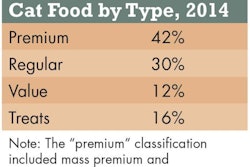Dry petfood produced in 2014 totaled 21.7 million metric tons globally, a 4.6% increase over the 20.7 million tons produced in 2013, according to the 2015 Alltech Global Feed Survey. This is a pleasant surprise, given that the same survey in 2014 showed little to no growth (less than 1%) in petfood volume from 2012 to 2013, and other sources also indicate relatively flat volume growth in most petfood markets.
Specifically, the 2015 report, the fourth annual feed production survey for Alltech, indicated petfood volume growth in Europe (from 5 million tons in 2013 to 5.7 million tons in 2014) and North America (from 8 million tons in 2013 to 9 million in 2014). That runs counter to most other data, which usually show flat petfood volume sales in those parts of the world.
In the US, for example, which comprises most of North American petfood sales, volume in the mass market channel increased only about 0.8% in 2014, according to Packaged Facts. GfK data for 2013 showed petfood volume sales in the US pet specialty channel actually decreased in 2013 (-3% for cat food and -1.2% for dog food, though value sales in US dollars rose 3.6% and 7.2%, respectively). And while petfood volume sales in Eastern Europe have been increasing at about 5% a year, according to Euromonitor, they are flat in Western Europe, which dominates overall European petfood sales.
As in Eastern Europe, volume growth is usually fairly strong in developing petfood markets; other examples include Latin America, parts of Asia and even Middle East/Africa. Yet the latest Alltech report shows no growth in Latin America -- petfood volume was at 5 million tons in both 2013 and 2014 -- small declines in Africa and Asia from 2013 to 2014 and zero petfood produced in the Middle East in either year.
Alltech's petfood volume data for the top 10 feed-producing countries includes even more surprises: 0 petfood produced in Germany, one of the largest petfood markets in Europe, or in India, which we know is a small but rapidly growing petfood market. The data also shows no volume growth for petfood in Brazil, stagnant at 2 million tons per year, even though other sources, such as Euromonitor and Sindirações (the Brazilian feed association), have petfood production in that country at nearly 2.5 million tons annually and growing.
I believe all the discrepancies lie mainly in how Alltech gathers its data. First, the company focuses on feed mills and companies. Some of those entities also produce petfood; yet this survey method likely doesn't include manufacturers producing only petfood or any producing wet petfood.
To be fair, Alltech's presents its survey results as an "estimate"? and offers these explanations and caveats:
"Alltech assessed the compound feed production of 130 countries. Where possible, information was gathered in partnership with local feed associations and, when that wasn't possible, it was done utilizing information collected by the more than 600 members of Alltech's global salesforce, who had direct contact with more than 31,000 feed mills. When reviewing the data, there are two considerations to bear in mind. First, numbers for less developed countries may be less accurate, but given their size, this had little numerical influence on the overall dataset. Second, the definition of feed, feed mill and species varied from country to country."
Despite the disparities from other reports, the Alltech survey does provide at least a partial picture of dry petfood production around the world, and the fact that this volume is growing is good news. Overall global feed production also increased in 2014, up 2.4% from 2013, to a total of 980 million metric tons, the survey shows. Besides petfood, pig feed contributed to that increase with growth of 5.4%, while poultry and ruminant feed production was flat.
Among the top feed-producing countries, Spain enjoyed a 10% gain, climbing to number five globally, after China, the US, Brazil and Mexico. India, Russia, Japan, Germany and France round out the top 10. While the 2015 survey results are not yet posted, you can find the 2014 survey on Alltech's website.
















